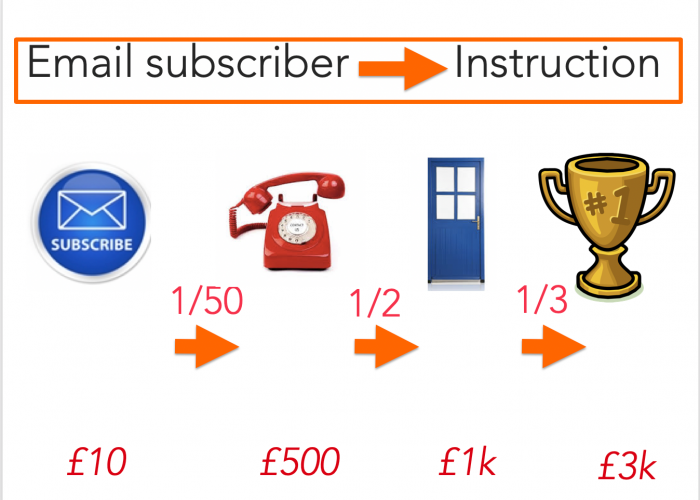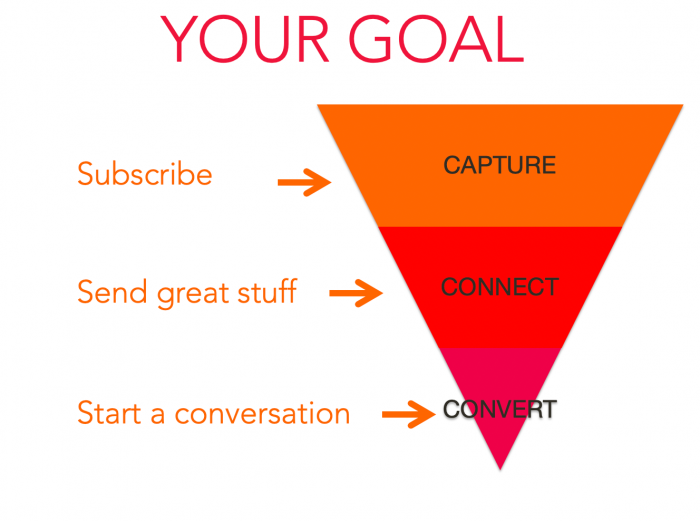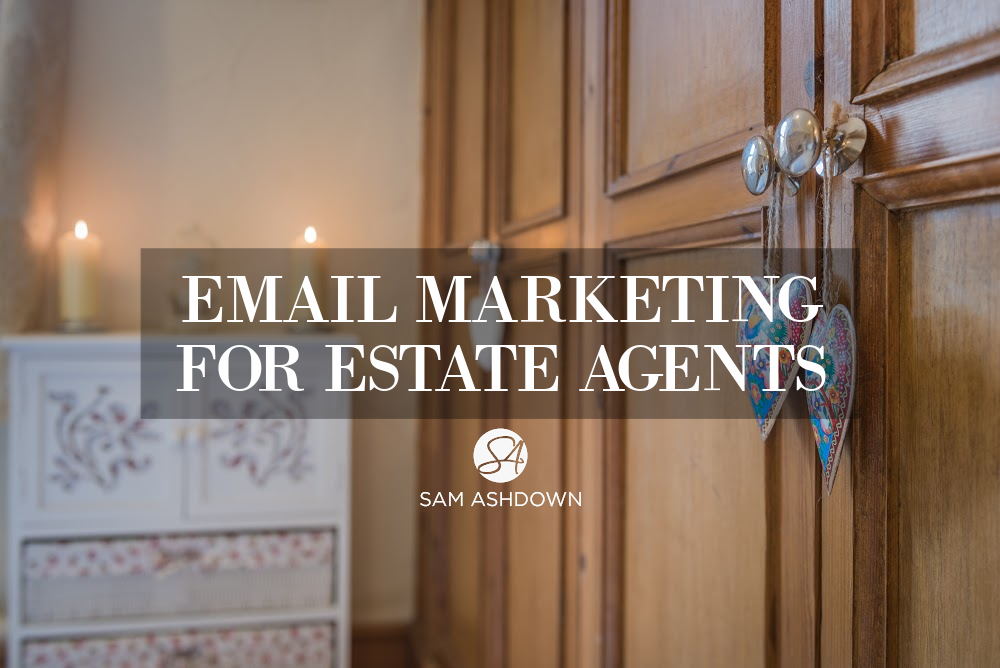Email marketing is abused and underused by most independent estate agents. But if you know what you’re doing, it’s actually a pretty straightforward marketing channel, with huge benefits for getting it right.
In this post, I explain why email marketing is so important for you as an independent agent, looking to grow your business, and how you can use email marketing to capture, connect and convert your ideal clients.
Here’s why email marketing is such an important topic for independent estate agents right now:
Your phone isn’t ringing like it used to – not with new vendor enquiries, anyway. How many calls do you get a week from sellers with a decent house, wanting to book a valuation? If it’s less than three, this post will help you to increase that number.
Marketing is getting more and more expensive – whereas once upon a time, you only had the paper advertising bill to worry about, now your marketing list is so much longer: Facebook Ads, Google Adwords, software, social media management, web development, content creation… the list goes on. With so much more choice, it’s hard to know where to invest your hard-earned cash to get the best return.
And it’s just not working like it once was – with more and more independent estate agents now using digital marketing, the goal posts keep moving. More competition means higher costs to you, and lower returns. That’s why, instead of doing what they’re doing but better, you need to do it differently.
The good news is that email marketing is very low cost, and easy to differentiate yourself with. In this post, I’ll show you:
- How to ‘mine’ your database
- Which subject lines get the most opens
- Exactly how to automate your emails
- Why your current CRM isn’t good enough
- How to convert a subscriber to a valuation
But first…
Why use email marketing?
It’s cheap – whilst there are plenty of free email marketing service providers to choose from, even the paid levels (which I recommend you use) start at only about fifteen quid a month.
It’s direct – unlike social media, where you really have no idea who is seeing your posts, email marketing gets straight to the recipient (spam folders notwithstanding).
It’s your data – it’s super important it is that you own the data and the platform you’re using. Facebook could change its rules tomorrow and you’re completely at its mercy. But your email list belongs to you, and no one can take it from you.
Instant feedback – when you send an email, the results are pretty much instantaneous. For example, I sent out a short email at 10.32 on a Tuesday morning. By noon I had 41 replies. By the end of that day, I’d had 73 responses. And by the time the last person replied, the total was up to 88. When was the last time you had 88 replies from a single email?
It’s permission-based – so long as you’ve set up your email database correctly, your email recipients want to hear from you. Unlike direct mail, which is unsolicited, an email from you will be expected and even appreciated.
They know you = warm prospects – you’re communicating with someone who knows who you are, which will dramatically increase your open rates and response quality and quantity.
But growing your audience the right way, takes time, care and a big dollop of respect.
Are you guilty of making these email marketing mistakes?
- Sending out newsletters
- Broadcasting all your listings
- Going straight for the ‘sell’
- Including loads of images
- Spamming people
- Starting and stopping
- No testing
- No segmenting
- No clear objective
You need to be smarter to win the email marketing game
Most estate and letting agents are simply blasting their lists with their latest listings. That’s not marketing; that’s ‘broadcasting’. And anyway, isn’t it vendors and landlords that you want? So why treat everyone like a buyer or tenant?
If you’re emailing out newsletters each month or so, you’re also missing a trick. Newsletters are all about you, and they want to know what’s in it for them. Think about your own bulging email inbox; the average person gets 147 emails a day. You may get even more. What makes you click on a certain email and ignore others? If you saw the word ‘newsletter’ in the subject line, would it rouse your curiosity? Or would you pass over it in favour of more juicy and compelling emails?
Some of my clients are using email marketing so well, they get all their new business that way. So instead of having to do leaflet drops, touting letters and expensive advertising, they focus on building up their email list, adding new, motivated vendors and landlords each day through clever online and offline marketing activities.
Email can be automated, so you can set up a series of emails to be delivered in a particular order over a set period of time, and the automation does the hard work for you, leaving you free to do what you do best – listing and selling or renting properties.
Email gets amazing results if you do it right. I recently checked the original source of my last 100 new clients, and discovered that over 90% of them had come from my email list.
Let’s look at the financial return of a typical marketing funnel
When you send out a ton of leaflets, your expectations of any responses will probably be low. The average response rate for leaflets is 1-2 in 10,000. That means that on an average fee of £3,000, each leaflet you send out is worth 30p.
By contrast, let’s say you need 50 subscribers on your email list, to get 1 phone call. Every 2 phone calls would net you one valuation, and you convert 1 in three of those to instruction. That means every subscriber you attract is worth £10. And you’ll help protect the planet from bulk leafleting into the bargain.

How to get your emails opened and read
- A great subject line – if your email doesn’t have a compelling subject line, you won’t get past the first hurdle. But don’t be tempted to use a ‘click-bait’ approach. I know marketers who use just the recipient’s first name as the subject, or ‘hi’. These tactics may get your email opened, but your response rate will be dismal, and your unsubscribe rate higher as a consequence. People just don’t like feeling they’ve been tricked into taking an action.
- Talk like a friend – don’t go all formal and pretend to be a corporate. Be yourself. Use words you usually use in conversation, and make sure your emails have a natural voice that reflects your personality.
- Give, don’t ask – you’re not writing to them to ask for a valuation. You’re writing to give them something that will enhance and strengthen the relationship you have with them.
- …except for questions – you can ask a question though, provided the answer is easy for them to respond with. “Tell me about your biggest selling challenge” or “Why are you moving?” are questions that are too big and involved for them to answer on an email, so you just won’t get the number of responses you may be hoping for. By contrast, “Which of these two for sale board designs do you like best?” is simple and easy for them to answer, and therefore you’ll get many more responses from an email like this.
- Add a PS – it’s a well-known sales letter tactic to add a PS, and that’s because it works. People are busy, and they will often only read the first line, and the PS. If these are compelling enough for them to go back for a second read, they’ll scan to see if your email is relevant and interesting to them. Your PS could be the difference between getting a response from your emails, and crickets.
- And a photo of you – there are a couple of reasons to add a photo of you at the bottom of your emails: 1) it adds a personal touch that is much more likely to elicit a response from the recipient, and 2) it allows your email service provider to more accurately measure your email open rates.
Get your subject line right and you’re halfway there
According to Marketing Sherpa, 86% of the success of your emails relies on your subject line.
Let me ask you this – which of these emails would you be most likely to open?
Three things you can do today to get more viewings
Company update: new Bromley branch opening this month
Connells’ Summer newsletter
If you answered #1, you’re right. The other two are actual emails I’ve received but not opened. The first one is mine, and has a 46% open rate, which is pretty good.
I’ve covered a lot of ground so far in this post, to help you take your email marketing to a new level, but I really want you to succeed in this endeavour, not just read this and carry on doing what you’ve always done. That’s why I’ve created this actionable list of steps you can take today to build your agency using email marketing:
Sam’s 5 step formula to use email marketing to grow your agency:
STEP 1 – Build your list
– focus on building a list of quality, motivated vendors and landlords. Use Facebook Ads, social media, blogging, leaflets and any of your regular marketing channels to drive traffic to an email capture, rather than trying to skip steps by going straight for the valuation.
STEP 2 – Create a nurture sequence
– write a series of emails that are full of tips and advice, and stay away from trying to sell them anything, then schedule it to save you time. By having your emails drip out at regular intervals, you’ll make sure your email subscribers stay warm, interested and engaged.
STEP 3 – Keep your subscribers separate from your CRM
– don’t try to use Vebra, Jupix or whatever CRM you’re using*, to communicate and convert your email subscribers. Instead, use a dedicated email marketing service, like Aweber, Mailchimp or Infusionsoft. We use Aweber, which I love. [Here’s my affiliate link – if you use it, I get a small thank you, so in return, I’d be happy to get you on the phone with my digital marketing assistant to talk you through how to use it.]
STEP 4 – Mine your database regularly
– your existing database – that is, all your past vendors, landlords and applicants – can be a real treasure trove of new leads. Instead of cold-calling them all, and ‘prospecting’ to them, take a smarter approach: email them asking if they would like something of value, e.g. an ebook, checklist or other informative, helpful piece of content that not only will tempt them to click to get it, it will also tell you something about them. For example, offering your entire database a checklist called ’17 Steps You Need to Take Before You Put Your Home on The Market’, means that anyone who chooses to download it is probably considering selling relatively soon. No need to segment your database, the checklist does the work for you.
STEP 5 – Encourage engagement at each step
– the purpose of your email marketing is to provoke a response from the recipient. A response can lead to an email conversation, which in turn can lead to a phone conversation, and then it’s only a very small step to be invited out. So ask questions that have easy answers; offer multiple-choice questions; ask for help and feedback. Any email that can generate a reply from someone on your email list is working for you, so copy the formula into other emails. Just don’t overdo it – you don’t need a question in each email.
*A word about GDPR
If you blast your CRM database with marketing messages, you’re in breach of the GDPR regulations. After all, why would someone who viewed a property with you in 2009 be happy to get an email from you today, offering a free valuation? Instead, by using a reputable email marketing service provider, you’ll stay within the rules, by getting your subscriber’s permission to send them useful tips and advice, monitoring your open rates and complaint numbers, and offering an unsubscribe option on every email.
What are you trying to achieve with your email marketing?
Your goal is to CAPTURE your audience’s attention, CONNECT with them by generating a response, and CONVERT them into a valuation appointment – when it’s appropriate and helpful for them to go to that next step.

Email marketing is the gift that keeps on giving
It’s probably the oldest form of digital communication, and still has the highest return on investment of any other marketing channel. With this kind of success rates, you can’t afford to ignore email marketing when you’re trying to grow your agency. Those agents who really embrace and value their email subscribers will reap the rewards down the line, as those subscribers eventually find themselves wanting to move or invest.
“Having been introduced to e-mail marketing by the amazing Sam Ashdown, we are now reaching out to many more potential clients in a non-intrusive, friendly and more importantly helpful way. Our ebook is actually something they have asked for, something they want. When potential clients do call us, they already feel they know us, and want to sell their property with us, half of the battle is won before we cross the doorstep for a valuation.” – Lucie Wishart, Wishart Estate Agents.
Ready to make the changes needed in your agency?
If you’d like a chat with my team to find out more about how we work, just tell us a bit about your business using this link, and let’s talk.
Sam



